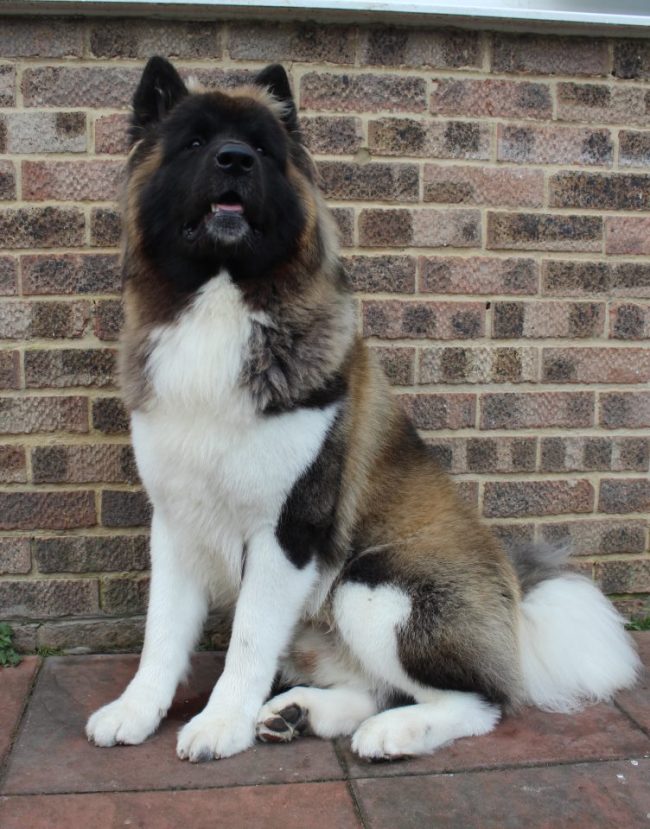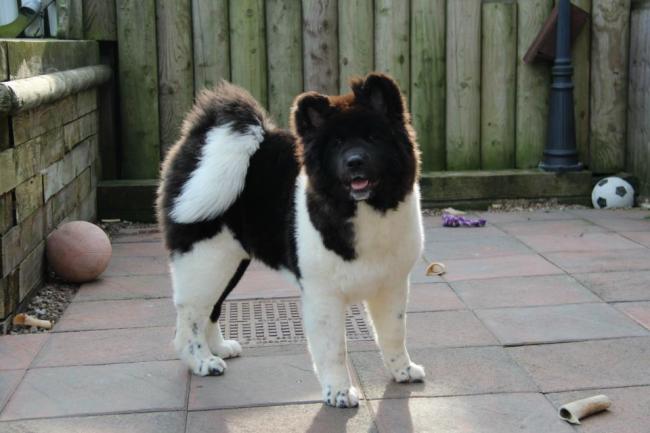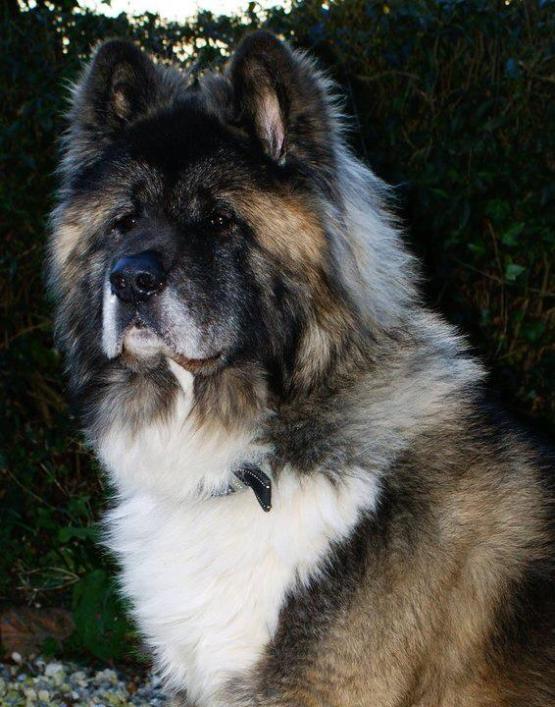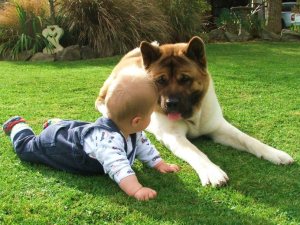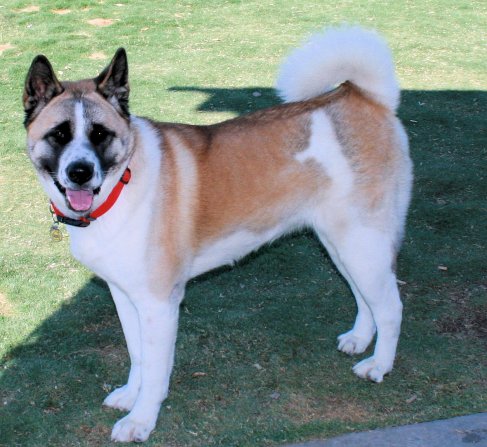Blog Archives
What’s a Longcoated Akita? (LC Akita)
The Long-coated Akita. There are many theories on how the long-coated Akita came to be, many believed that in the 1900s the Karafuto dog was introduced into the Akita bloodline. The Karafuto was a spitz type hunting dog, with small pointed triangular ears, hair was long, fine and thick with a very dense undercoat. These attributes are very similar to the Long-coated Akita. The Long-coat has many variations in coat length, from a slight feathering, to a huge wooly coat, sometimes reaching down to the Akitas feet. The coat will feel softer and silkier than the short coat due to the longer guard hairs and very dense undercoat, they have a very loving and kind disposition, are larger boned and extremely eager to please when it comes to training. Most breeders agree they are gentler by nature than their short-coated counter parts. The Long-coated Akita resemble extremely large cuddly teddies and are people magnets, But they are still a full bloodied Akita and will need the same levels of training and socialization, if not more so as people are drawn to them. They are often referred to as woolies or silkies, requiring a little more grooming than the short-coat. If left unkempt they will become matted and tangled, which is very uncomfortable for the Akita. They make excellent companions, whilst maintaining the characteristics of the short-coat. They have a high instinct to protect family members, quietly watching for threats, whilst appearing relaxed. They also make excellent guard dogs.Whilst the Long-coated Akita is considered a blatant fault with the majority of Judges, the Long-coat much to popular belief can be shown, But considering all the faults and disqualification within the breed, there is a huge stigma surrounding the Long-coat and it is almost never seen in the ring. In fact, until recently most people weren’t aware they even existed. This said, many breeders will have long-coats in their litters and most lines carrying the recessive gene will have fuller thicker coats. There have been a few petitions to get the Long-coated Akita recognized in a classification of it’s own and many believe these beautiful creatures should be seen in the ring. Although this throws up a lot of heated debate due to the variation in coat lengths and many breeders also fear the long-coat would become more popular than the short due to their heightened appeal.
soo watch this space !!
Written By Koda Naiya Sharpin Vez
Should i breed my Akita?
Put bluntly, there are currently too many poor quality AKITAS being bred simply for commercial purposes. These AKITAS are then sold on to naive, unprepared new owners with little knowledge or understanding of the breed and when the “cute” puppy becomes a big mischievous teenager, that is when they are likely to be sold on or given up to the already over run, crowed Akita rescues for rehoming!
If you are thinking of breeding your Akita dog/bitch, these are some of the things you need to think about:
1. How do you know your Akita dog/bitch is good enough to breed from?
In order to ensure that the Akita breed retains the qualities which make it what it is, any Akitas bred from need to be as close to the breed standard as possible. How do you know if your dog is good enough? The best way of ascertaining this is to both show and work your Akita(s). Success in the show ring under knowledgeable judges will indicate that your Akita is of good quality. You should look to achieve at least a Kennel Club Stud Book Number as an indication of quality as assessed in the show ring in the field (agility). Without some degree of show success and the ability and willingness to work effectively in harmony, dogs are unlikely to be good enough to breed from.
2. Is your dog Kennel Club Registered?
Although KC registration is not a guarantee of quality, the lack of KC registration is usually an indication of poor quality commercial breeding. KC registration is at least a strong indication that the pedigree of your dog is accurate and honest. This will help in checking the health records of your dog’s ancestors. Without KC registration, this will be impossible.
3. Have the appropriate health tests been carried out on your dog/bitch?
If your dog is KC registered and has proved its quality in the show ring and on the trail, has it had the appropriate health tests for the breed and satisfactory results achieved?
Hip dysplasia is not a major problem within the breed although, of course it does occur very occasionally, and the way this situation can be maintained and improved is by every breeder hip-scoring his/her dogs under the BVA scheme. The current breed average hip score is 13. No ethical breeder would breed from a dog whose hip score was in double figures or where the scores of dog and bitch added together came to 20+.
Eye Problems – again, these are not common within the breed, but, unfortunately are not unknown. Both Primary Glaucoma and Hereditary Cataracts. Other conditions for which testing is recommended are PRA (Progressive Retinal Atrophy), PPM (Persistent Pupillary Membrane) and CD (Corneal Dystrophy).
It is not enough to ensure that your dog and its prospective mate have good hips and clear eye tests. You also need to look back several generations to make sure that you have four or five generations all clear of issues. Eye problems in particular can sometimes skip generations and suddenly reappear in the litters of dogs with clear eye tests. It is crucial that earlier generations are also clear.
4. How Many Litters Has Your Bitch Had?
How old is the mother and how many litters has she had? No bitch should be bred before the age of 2 years or after the age of 7. There should be at least a year between successive matings and no bitch should have more than three litters in her lifetime.
5. Can you afford to have a litter?
Although commercially minded breeders regard breeding as a money-making enterprise, the reality is that if things go wrong, you could end up losing thousands on a litter. If for example the mother needs a caesarian and as a result rejects the pups so that you have to spend 2 weeks or more handfeeding them every couple of hours 24/7, it is going to cost you a bomb in vet fees, puppy milk, baby bottles and probably in terms of time lost from work.
6. Do you have a waiting list?
The puppy farmers, backyard breeders and naive/stupid/greedy “pet” breeders are finding it more and more difficult to sell their pups in our current financial climate. Before you even think of breeding, you should ensure that you have homes waiting for any of the pups that you are not going to keep.
7. Letting the puppies go to their new owners
Puppies should never go to their new owners until they are at least 8 weeks of age. This is crucial in terms of the important lessons the pups are learning from their mother at this stage.
8. Taking Back Your Breeding
Even when you have sold your pups to the best possible homes, disasters can happen and people sometimes find it impossible to keep their Akitas(s). Are you in a position to take back any dogs which have been bred by you at any time in the future, no matter what age they are? Ethical, responsible breeders will always do this.
These are just some of the factors you need to think about before breeding your Akita. Akitas are being over bred especially in the UK, why add to this over populated gene pool? True Akitas lovers will not breed unless all for the right reasons, to improve and this being achieved in an ethical breeding scheme. If the above are not carried out then you will be labeled a BYB(back yard breeder) and surely you don’t want the blame of ruining the Akita breed and it’s future, do you? Think twice before considering breeding. There’s too many out there and as a result too many suffering and the Akita rescues full to capacity don’t breed, keep them our secret keep their numbers down! 
Love Akitas? Join us on facebook!

Facebook Links below. Our group is the biggest Akita group and one of the largest dog groups on facebook, now with a new experienced, helpful admin team! All dog are lovers welcome across our sites!
Akita World Group- 13,000+ members!
https://www.facebook.com/groups/6884242271/
Akita World Rescue –
https://www.facebook.com/AkitaWorldRescue
Akita World Fan Page – Nearly 50,000 Likes!
https://www.facebook.com/akitaworld
Akita World Scotland –
https://www.facebook.com/groups/520646177964892
Akita World smaller group –
The Akita and the Alpha role.
Who’s in charge?
The purpose of this article is to demonstrate what role the Alpha plays in your Akita pack, or family. Let’s start with understanding how a dog perceives the world around him and how that world will best function for him. To begin with the domestic canine has been trained and bred over the last few thousand years with companionship, loyalty and lack of aggression, in mind. Through hundreds of generations, man has attempted to eliminate the dog’s wolf like tendencies. So that he may live in harmony with that human family without difficulty. The problem of course is that you’ll never completely breed the natural Wolf instincts out of the canine. What are these instincts? First, all canines are pack animals. This gives them a base visceral instinct towards responsibility to its pack. Dogs feel like it’s their job to protect and watch over their pack so that no harm comes to the Alpha. This quality is one of the things we love the most about our Akita’s. You see, the Akita is the most natural guard dog in the world today. This is due to their close DNA connection to the Wolf. Dog experts will warn against “Guard Training” an Akita, since this could confuse the natural behaviors of the breed. So the trick to a calm well-trained and, most importantly, well behaved Akita, is to create, as close as possible, a pack like atmosphere. This is so the animal can relate and find comfort, security and be contented. To try and bring this into perspective, let me explain that the biggest problem with any dog’s behavior is that they are afraid. Not cowardly, but naturally cautious. They must be on alert for danger at all times. A frightened dog is a dangerous dog! Let’s examine how a pack is structured to function in alleviating their fear .The top of the order, within the Wolf hierarchy, is the Alpha male. This senior male Wolf is not just the boss in the eyes of the other Wolves. He is in fact, God. To the other wolves all things good or bad come to them from their Alpha. Next in order is the Beta female. This female is typically the oldest and chosen by the Alpha male for that position. Nothing happens in that pack, unless the Alpha consents. Her job is to teach the young, and advocate for the other females also keep order in the pack. By creating this structure all the other wolves have a sense of calmness and security. The stronger and stricter the Alpha, the more the pack is calm. If at any point they lose their Alpha male, or their beta female, the disruption to the hierarchy within the pack becomes more noticeable by the hour. The other wolves start to become insecure, skittish, nervous, and generally aggressive. This is because they have lost their natural protector and provider. This insecurity will go on until a new alpha male is established. Typically this is done through young males fighting each other until one rises to the top, and assumes command. This also will most likely create a new beta, chosen by the new alpha. A Wolf pack without this hierarchy is doomed. This is a natural occurrence and there is no example in nature where a Wolf pack is run by “Majority rule” or “Every man for himself”. If you, as an Akita owner, want a well behaved loyal non-aggressive Akita, you must learn to mold your family into an Akita pack, at least in the eyes of your dog.
” How to establish yourself as the Alpha to your Akita”
If your dog is a puppy 8 to 12 weeks old, then this process is a simple one. At 12 weeks call your puppy over and gently, while petting her or him, cover the side of his face with one hand while expanding the other to completely control the side of the puppy’s body. Gently steadily using as much strength as necessary but not abruptly, press the dog onto his side and hold him there. At this point I make it as clear as possible; you absolutely, positively have to hold that dog, so that you decide when he is to stand up. At this point your puppy will whine, wiggle, and do everything it can to regain control and stand. It is this process of you preventing your puppy from standing when it feels like it that establishes you as its Alpha. At some point, and it may take up to five minutes, your puppy will submit. You will be able to tell simply because the puppy literally seems to die. Goes completely limp and waits for you to let him up. Two important points; first, always be talking sweet to your puppy. Two, never allow your dog to stand up on its own during this process. If he does, he wins, and regains his alpha status. If you do this once a week until your dog is six-months-old then do it once per month till he turns a year old, you will be that dogs Alpha for the rest of his life. You will notice each time you perform this, it will get easier. By the time your dog is six months old he will come to you when you call, and as soon as your hands are placed on the side of the dog, he will drop and submit.
If you combine this technique with alpha behaviors such as; your dog never eats first, your dog never gets further than 50 feet from you, you are first, not the dog, to walk through your door, and your dog never shares the furniture with his alpha, never! If this is done properly you will never fear your dog running from you again nor will you worry about your dog’s behavior. Why? Your dog now has a responsibility. He must spend every waking moment trying to please you and gain favor with you because you have now become his God. Why you ask will the dog stay within 50 feet of you at all times? Simple, try and put yourself in his mind and imagine if God came to you and said I will be living with you from now on. Also you will need to protect him against any danger. How far from him would you drift? How close would you want to be to him? How often would you allow him out your site? Truthfully, wouldn’t you have a unique sense of wellbeing? I mean how safe are you and your Family now? This is how your Akita feels around you, his Alpha. Opening your front door is no longer a way to escape. Instead it is a portal where danger can enter and your Akita will prevent that from happening. If you find this hard to believe I offer the following example; my three-year-old Akita bitch “Maggie” will not under any circumstances ever leave my home while I am in it unless I order her out in which case she will go reluctantly, never let the door out of her sight and beg to come back in as soon as I let her.
The procedure to Alpha an older dog becomes trickier. First you must evaluate the animal. If he or she is an “Aggressive” then you must work with the dog to calm him down and socialize the Akita. While doing this, you should start establishing yourself as your dogs Alpha, with your behaviors. These include, but are not limited to, not allowing your dog on the furniture. Not allowing the dog to sleep in your bed. Not allowing your dog to step in front of you while walking him or when you are entering or leaving your home. When you start to feel the comfort level in the relationship between you and your dog is a calm, gentle one , then I would suggest that you go to your favorite quiet room, talking sweet to your dog, hold on to the scruff of his neck and place your hands on his right hip. Take extreme caution not to allow your dog access to your flesh. If your dog acts aggressive and you feel that this is too dangerous, do not continue. Wait until a better time, and try again. Always stay patient when training your Akita. This may take numerous times but it is imperative that your dog understand that he will be placed under your control completely. Always remember to a dog, gentle discipline is interpreted by him as your love. The great Dog Trainer, Caesar Milan says” To a dog, discipline is love”. In conclusion, I will leave you with this. You are in possession of one of God’s greatest gifts. By all accounts the Akita is one of the oldest canines, but what you don’t know, is that the Akita is spiritual. This dog will read your emotions, your thoughts, your moods and your health. He will spend the rest of its life doing everything it can to gain your favor, see your smile and make you love him with all your heart. Oh, I know, they get really big and most people who have two cents worth brains are cautious around them. But remember, just because the dog can cause damage does not mean he will. No, you’re happy, calm Akita is literally, a “Teddy Bear”. Be careful not to yell at your dog in anger and NEVER strike him. This behavior will create an aggressive Akita.
Yes, once your dog is established in your pack you now have the most natural protective barrier between danger and your family.
If the U.S. founding Fathers would have all owned Akita’s, then the 2nd amendment would read “All citizens have the right to own and proudly display an Akita”, guns would be an unnecessary, useless deterrent in comparison to the Akita’s World.
Victor J. Lockwood
Welcome to Akita World
Welcome to Akita World, here we only have one passion and that’s AKITAS!
Akita World was set up to unite lovers of the Akita from around the world. We aim to promote and protect this breed to our fullest! We have set up this Blog to expand our presence over the internet, in the hope we reach more people but more important to help more Akitas! If you didn’t know we started off on Facebook back in 2008 and have grown in popularity ever since, now with over 60, ooo fans worldwide, the biggest Akita sites on facebook, a youtube channel, twitter account, blog and an exciting website in the making. Over the years Akita World has done some fantastic things, we have found many a fur’ever home for those in need of re-homing, raised thousands for Akitas needing medical treatment, been a place of comfort to those who have sadly lost their Akita, helped hundreds of people weekly with friendly advice, promoted Rescue and ethical breeders to those looking at bringing an Akita into their lives and much much more. We hope you enjoy visiting here, we want to bring you happy Akita blogs, helpful information blogs and anything we feel you would enjoy blogs! As all ways, we send you lots of AKITA LOVE!
Akita World.
